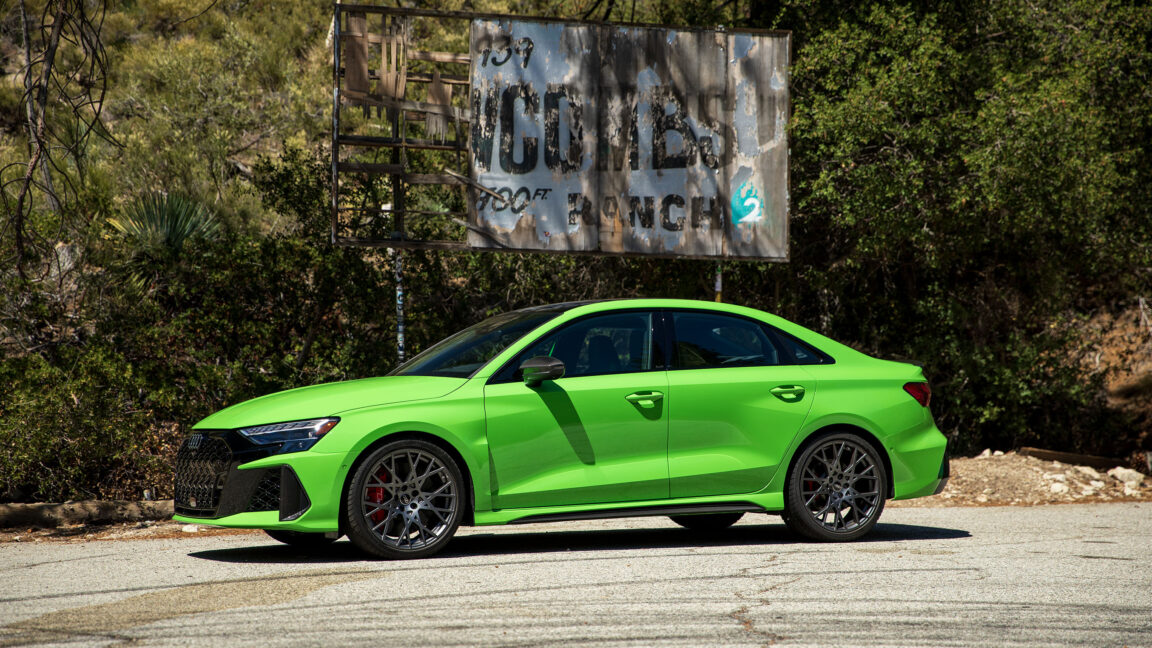
Credit: Bradley Iger
First offered in a passenger car by Mercedes-Benz back in 1974, the five-cylinder engine has always been a bit of an automotive oddball. The unconventional configuration eventually gained a foothold in the 1980s with manufacturers who needed a transversely mounted motor that was narrower than a V6 but wanted something smoother and more powerful than an inline-four.
For a time, the engine, with its distinctive exhaust warble, became closely associated with Audi’s lineup, aided in no small part by the motorsport successes of five-cylinder rally cars like the Sport Quattro S1 E2. But as technology progressed and turbocharging became more prevalent, the need for a straight-five layout dwindled. Today, the $63,400 RS 3 is the final five-cylinder holdout—not just for Audi, but for production cars in general.
In an era increasingly focused on electrification and modularity, the improbable introduction of the second-generation RS 3 back in 2022 seemed like fan service—an apparition that would likely vanish after a handful of diehards got their fill. But despite the headwinds that traditional performance cars have faced in recent years, the RS 3 not only lives on, it has actually been refreshed for 2025. While the tweaks are more evolutionary than revolutionary, they make what was already a highly entertaining sports sedan even more compelling. Well, for the most part anyway.
On the outside, the RS 3 scores new front and rear fascias that clean up the look, while new matrix LED headlights and a new 19-inch wheel design bolster the performance-oriented vibe. The cabin, meanwhile, is outfitted with new multi-colored ambient LED lighting, a new low-profile shifter design, and a new steering wheel that incorporates two dedicated drive mode buttons and aluminum paddle shifters. The steering wheel’s C8 Corvette-style flat top and bottom design complements the interior’s angular theme, but the touch-sensitive control panels on the spokes (which replace the physical buttons and dials on the outgoing car’s steering wheel) feel like a step backward in terms of accuracy and overall usefulness.
Unicorn of a powertrain
One thing that hasn’t changed, though, is the RS 3’s centerpiece—the 2.5-liter turbocharged inline five—which continues to send 401 hp (300 kW) and 369 lb-ft (500 Nm) of torque to all four wheels through a seven-speed dual-clutch transmission and a sophisticated multi-clutch rear differential. Known as the RS Torque Splitter in Audi parlance, up to 50 percent of the available torque can be sent to this active differential, and the unit is capable of then sending up to 100 percent of that to a single rear wheel as needed. This, in turn, significantly reduces understeer and allows the RS 3 to dance in ways that other front-wheel drive-based AWD performance cars cannot.
Audi saw fit to update the hardware that controls the differential, an upgrade that provides the system with more precise control over the amount of torque that it sends to each rear wheel at any given time and further hones the behavior of the brake-based torque vectoring system. This, along with refinements to the calibration of the RS 3’s adaptive dampers, make up the lion’s share of performance-related updates for the refreshed machine. Although these might sound like minor improvements, the revamped car was able to shave more than seven seconds off the outgoing model’s class record-setting Nürburgring lap time, so it’s clear these changes weren’t made just to pad the press release.
A press of the ignition button brings the five-cylinder to life with a boisterous growl that’s unlike any other performance car sold today. The 2.5-liter five-cylinder is derived from the same family of engines as the V10 that motivated the dearly departed Audi R8 and Lamborghini Huracan, and while it can’t match the banshee wail of that high-winding, naturally aspirated mill, the RS 3’s exhaust note makes its lineage clear and serves as an ongoing reminder that you’re behind the wheel of something special.
Outfitted with the optional sport exhaust system, as our tester was, the RS 3 will dish out all sorts of aural fireworks in the Dynamic and RS Performance drive modes (as well as customizable Individual drive mode, if you choose to set it that way), but it can also quiet down to a barely perceptible hush with mellower settings enabled. The ride is appropriately firm for a track-tuned sports sedan, yet not uncivil when you’re simply cruising around town, and the RS sport seats strike a solid balance between comfort and lateral support. The dual-clutch gearbox is also happy to perform its work in the background without drawing much attention to itself, and it will dutifully drop down a gear or two to provide effective passing power with only minor throttle inputs, even in the default Auto drive mode. It’s a formula that makes the RS 3 both fun to drive and easy to live with on an everyday basis, even if your commute doesn’t include a hot lap of Laguna Seca.
Take the long way home
But the canyons are where the RS 3 and its trick rear differential really prove their worth. Set the drive mode to RS Performance and this compact sedan rewards you with sharp turn-in and mild at-limit understeer, which progresses into easily collected oversteer, a combination that makes the RS 3 feel more like a rear-wheel drive car than any other front-wheel drive-based vehicle I’ve driven. Audi quotes an official 0–60 mph (0-97 km/h) sprint in an impressive 3.6 seconds, and the RS 3 does feel legitimately rapid off the line, but that urgency quickly tapers off as the pace increases. That might be for the best, though, because even with the optional carbon ceramic front brakes in the mix, the brake pedal’s travel is long, and the feel is spongy. Neither attribute inspires confidence when you’re exploring the dynamic limits of a vehicle, but it’s worth noting that the stopping power remained consistently strong, if a bit imprecise, even during extended stints in the hills.
And as with the outgoing car, the RS 3’s party piece is the RS Torque rear drive mode. With this setting enabled and the traction and stability control nannies put to bed, the RS 3 will perform big, smoky drifts and seemingly endless powerslides that feel surprisingly natural to execute and effortless to maintain, as it’s nearly impossible to coax the car into a full spin. It’s an experience that even the all-wheel drive Volkswagen Golf R (which shares a MQB platform architecture with the RS 3) can’t replicate, and it adds another layer of distinction to a car that already feels pretty unique.
With Audi’s five-cylinder-powered TT-RS sports coupe and RS Q3 crossover both put out to pasture in recent years, it feels like the RS 3 and its idiosyncratic power plant are already living on borrowed time. But if the RS 3 does indeed prove to be the swansong for this engine configuration in passenger vehicles, at least we’ll be able to rest easy knowing it went out on a high note.

-
 C114 Communication Network
C114 Communication Network -
 Communication Home
Communication Home


